Abstract
1. Plasma and adipose tissue purine nucleosides were assayed by reversed phase high-performance liquid chromatography after purification of the samples on phenylboronate affinity gel. 2. The adenosine content of unstimulated subcutaneous adipose tissue was close to 1 n-mole/g. The concentrations of adenosine and inosine in canine arterial plasma were 0.26 +/- 0.03 and 0.16 +/- 0.03 microM, respectively. In venous plasma from the canine subcutaneous adipose tissue the corresponding values were 0.32 +/- 0.04 and 0.28 +/- 0.06 microM under basal conditions. The arterio-venous concentration difference of adenosine was linearly dependent upon the arterial adenosine concentration. At arterial concentrations below 0.3 microM there was a net production of adenosine; above 0.3 microM there was a net extraction of approximately 77% of the adenosine. Adenosine was extensively eliminated in blood. The major part of this elimination could be accounted for by metabolism to inosine, hypoxanthine and uric acid. 3. Following sympathetic nerve stimulation (4 Hz for 20 min) the rate of adenosine outflow from adipose tissue increased from 0.33 +/- 0.22 to a peak value of 1.2 +/- 0.26 n-mole/min. This corresponds to a net release of 8.7 +/- 3.0 n-mole/100 g tissue. Inosine outflow rose from 0.64 +/- 0.37 to 5.3 +/- 1.4 n-mole/min, corresponding to a net release of 24.6 4/- 8.7 n-mole/100 g. Nerve stimulation also increased the release of [3H]purines from [3H]adenine pre-labelled adipose tissue. The fractional release increased 15-fold after stimulation. The radioactivity was mainly in the form of hypoxanthine, inosine and uric acid while adenosine was a minor component. When metabolism in blood was inhibited by dipyridamole and an adenosine deaminase inhibitor nerve-stimulation-induced release of [3H]purines was mainly in the form of adenosine. 4. Noradrenaline injection also induced a release of radioactive purines and of inosine. On the other hand, the outflow of endogenous adenosine was very small. 5. The present results demonstrate that under basal conditions adenosine is present in arterial and venous canine plasma. The free extracellular tissue level may be similar to the basal arterial adenosine concentration. Sympathetic nerve stimulation and noradrenaline induces a marked release of adenosine which is rapidly metabolized in the tissue and blood stream to inosine, hypoxanthine and uric acid. In adipose tissue the levels of adenosine reached after adrenergic stimulation appear high enough to be of physiological relevance.
Full text
PDF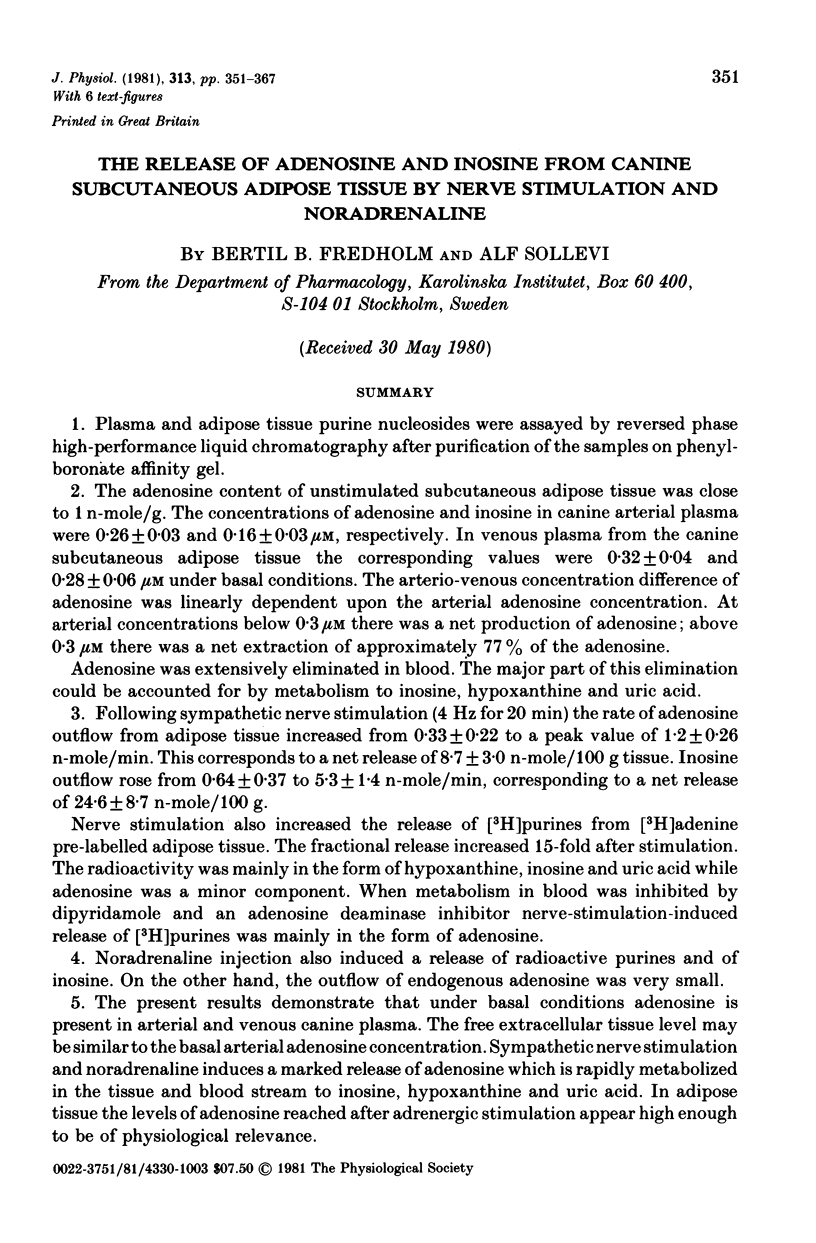
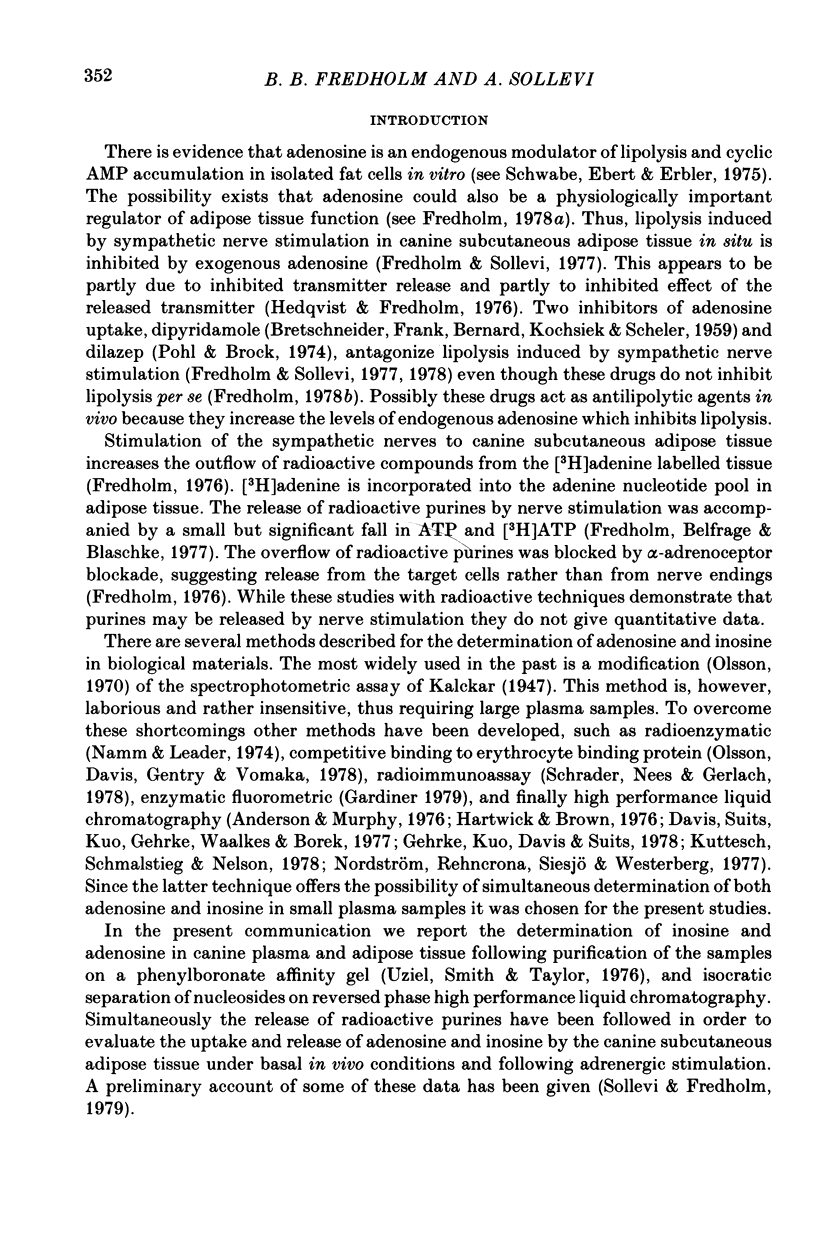


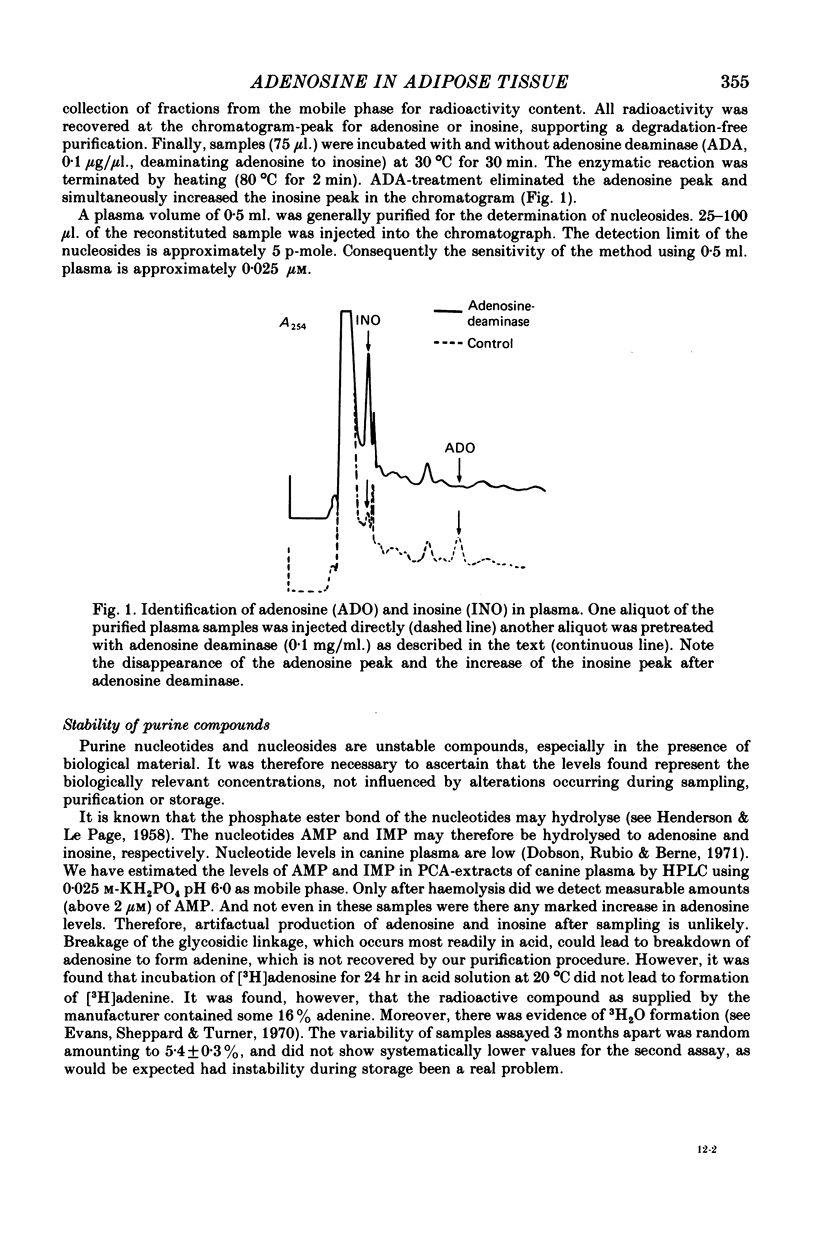

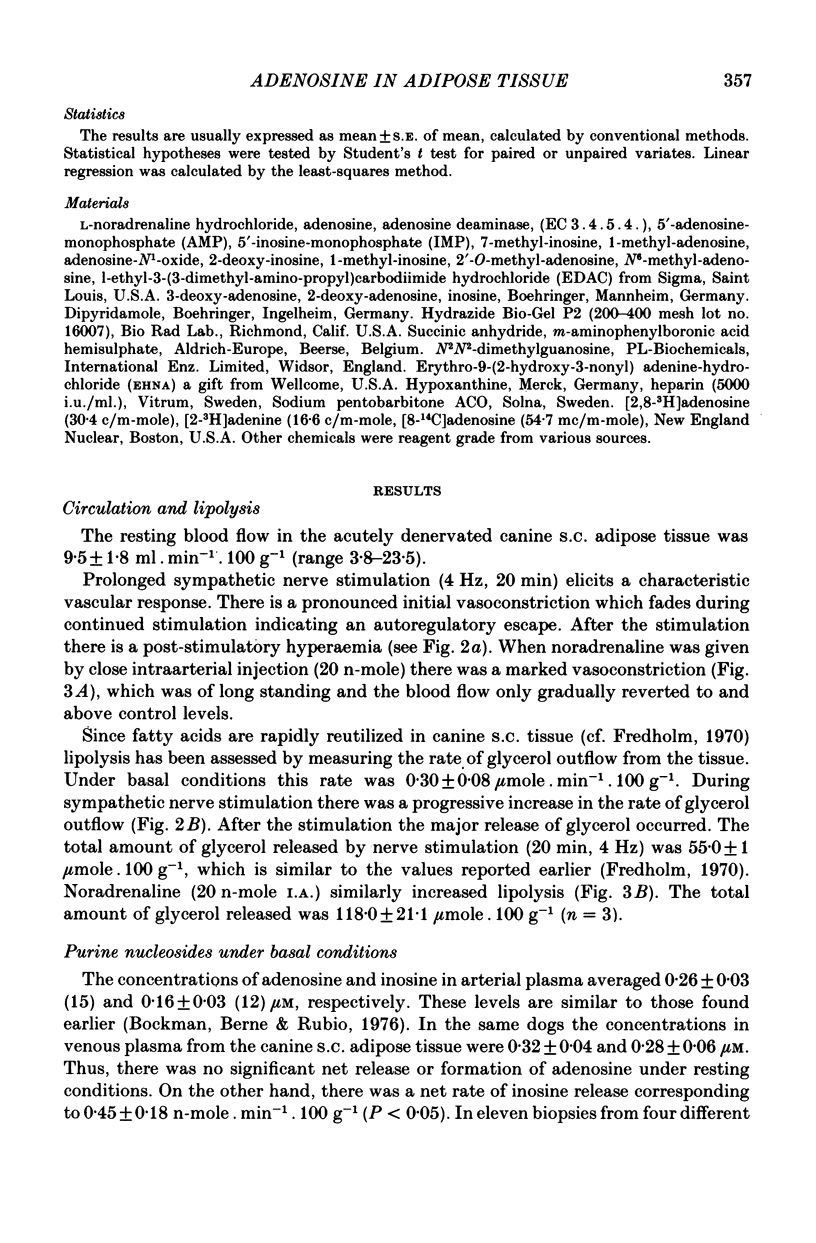
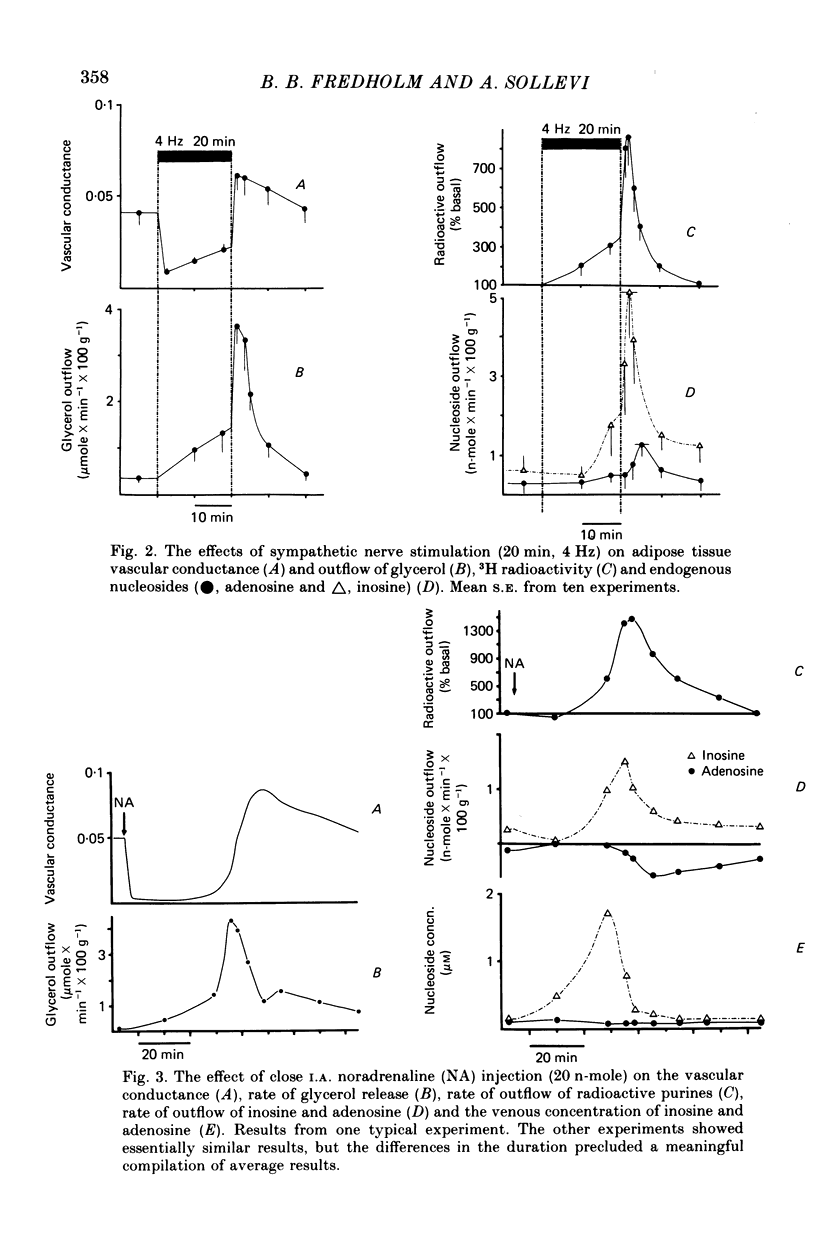
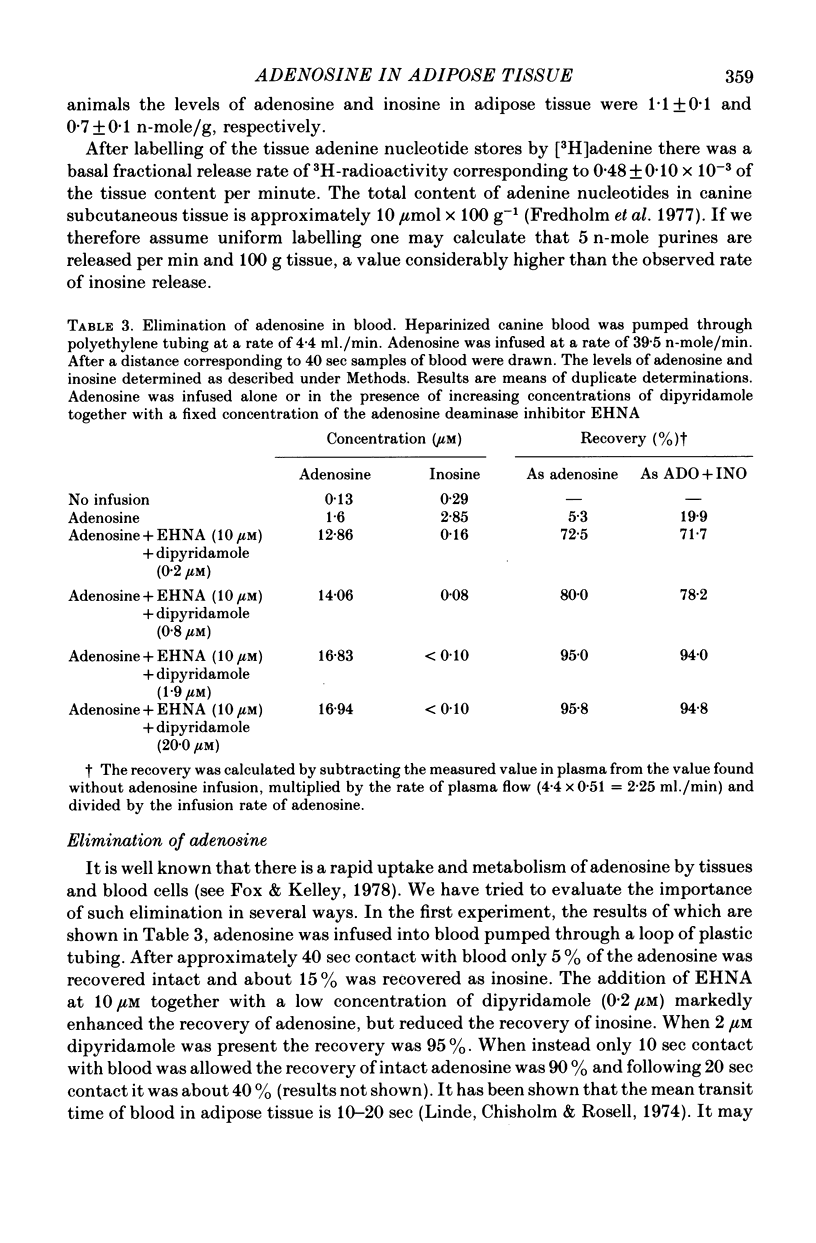
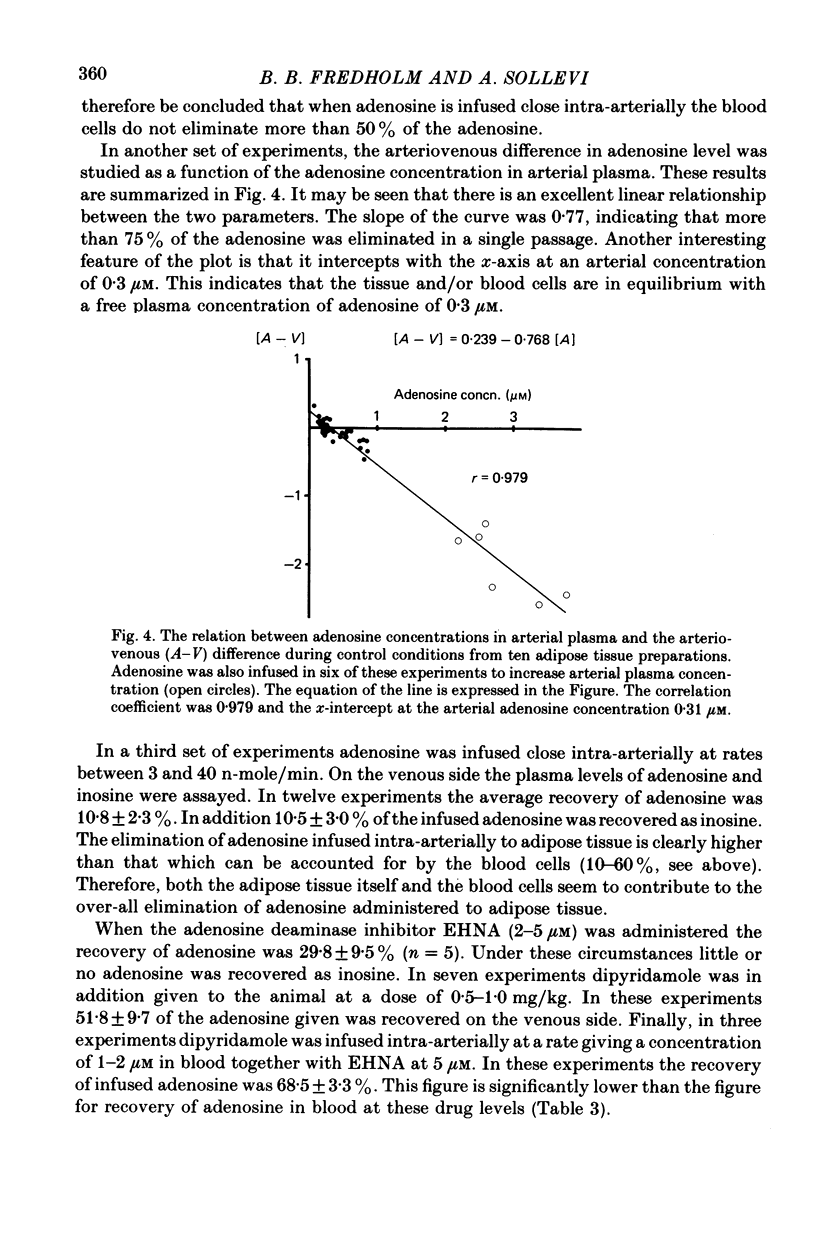

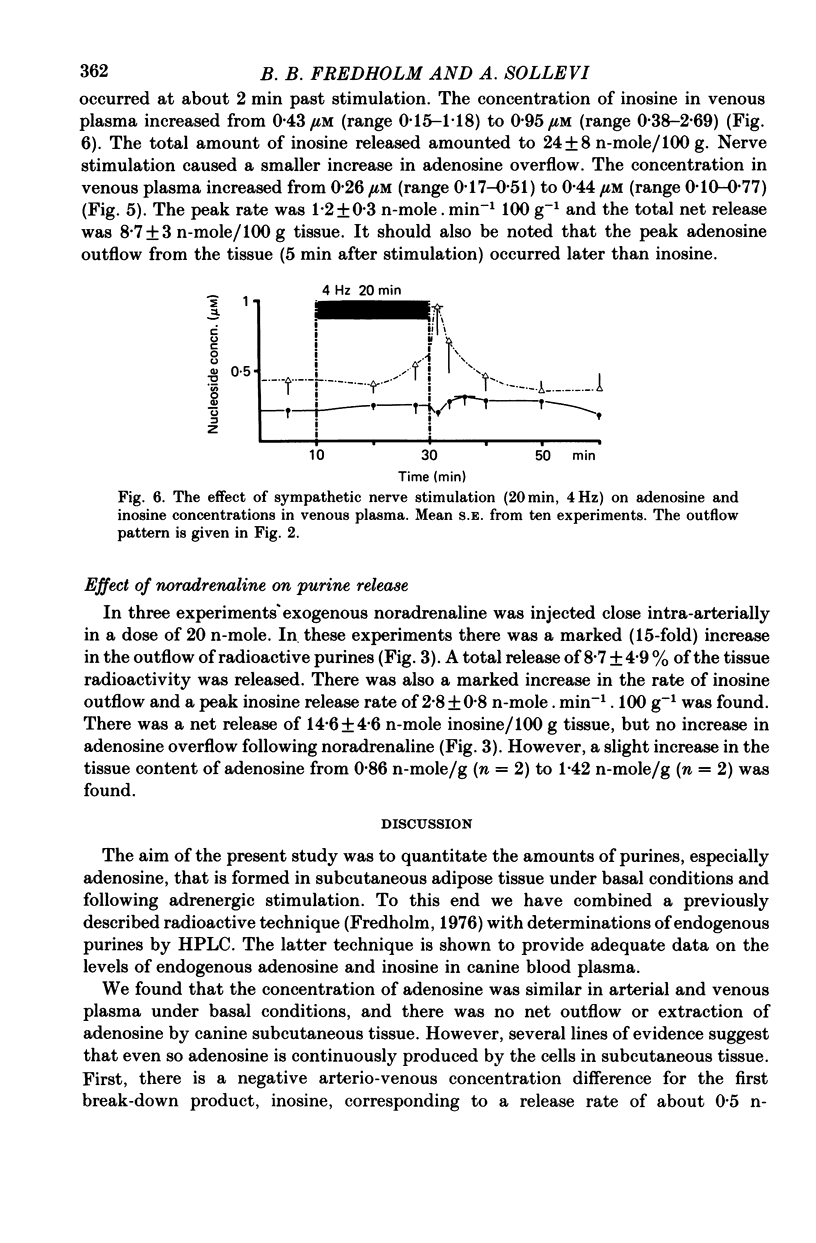
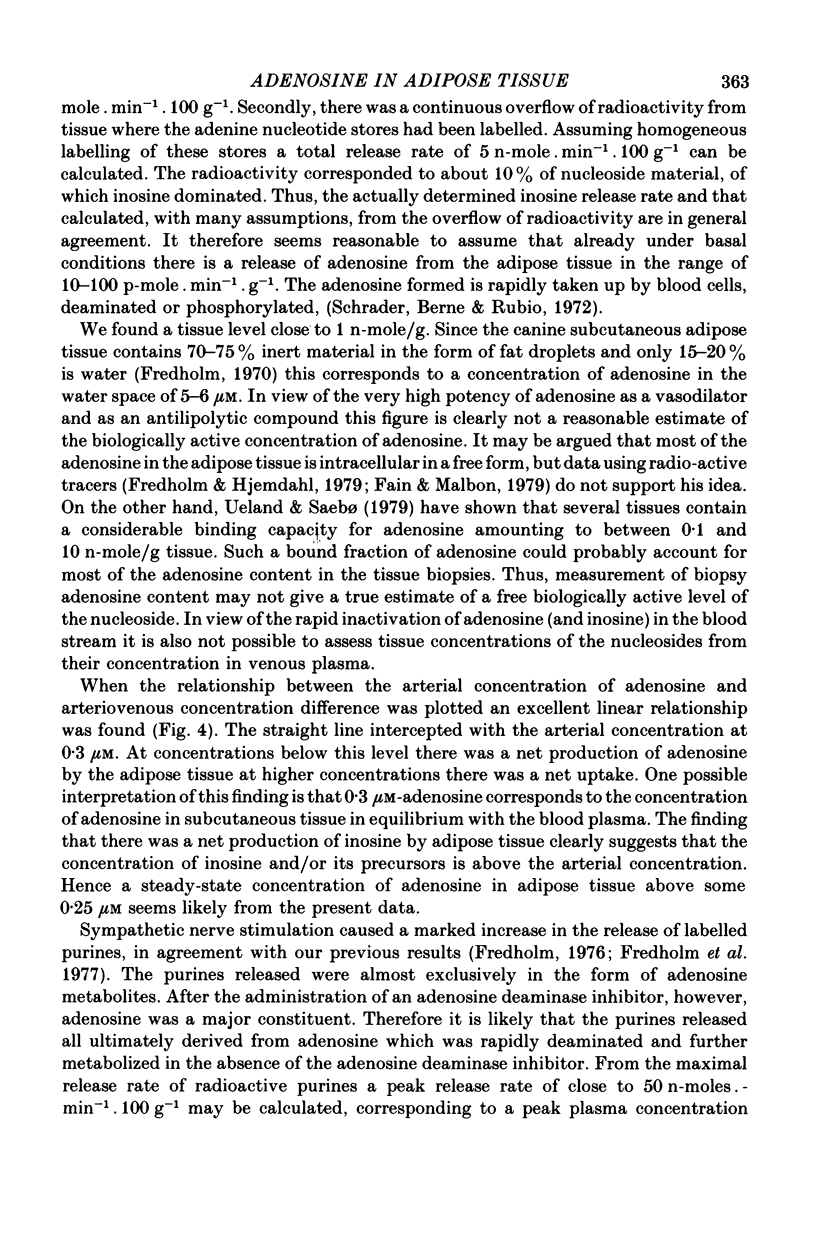
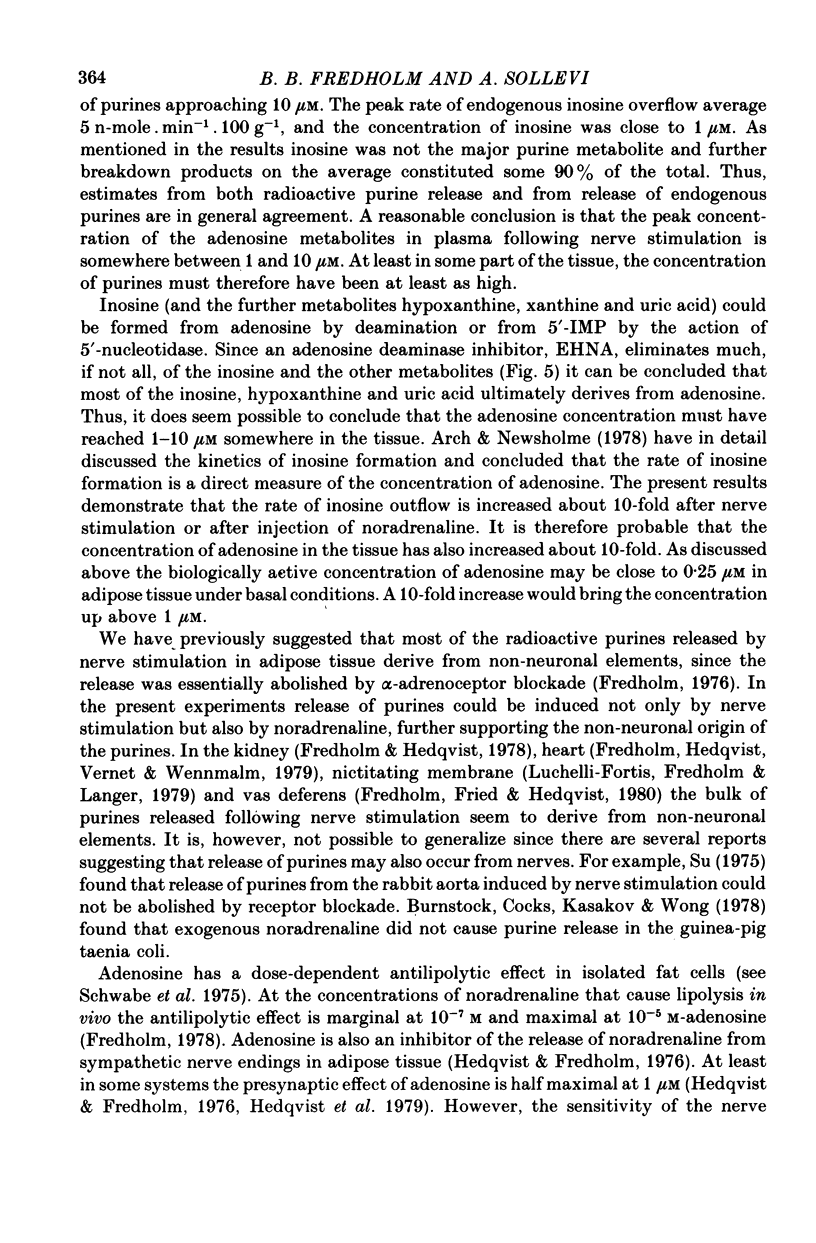

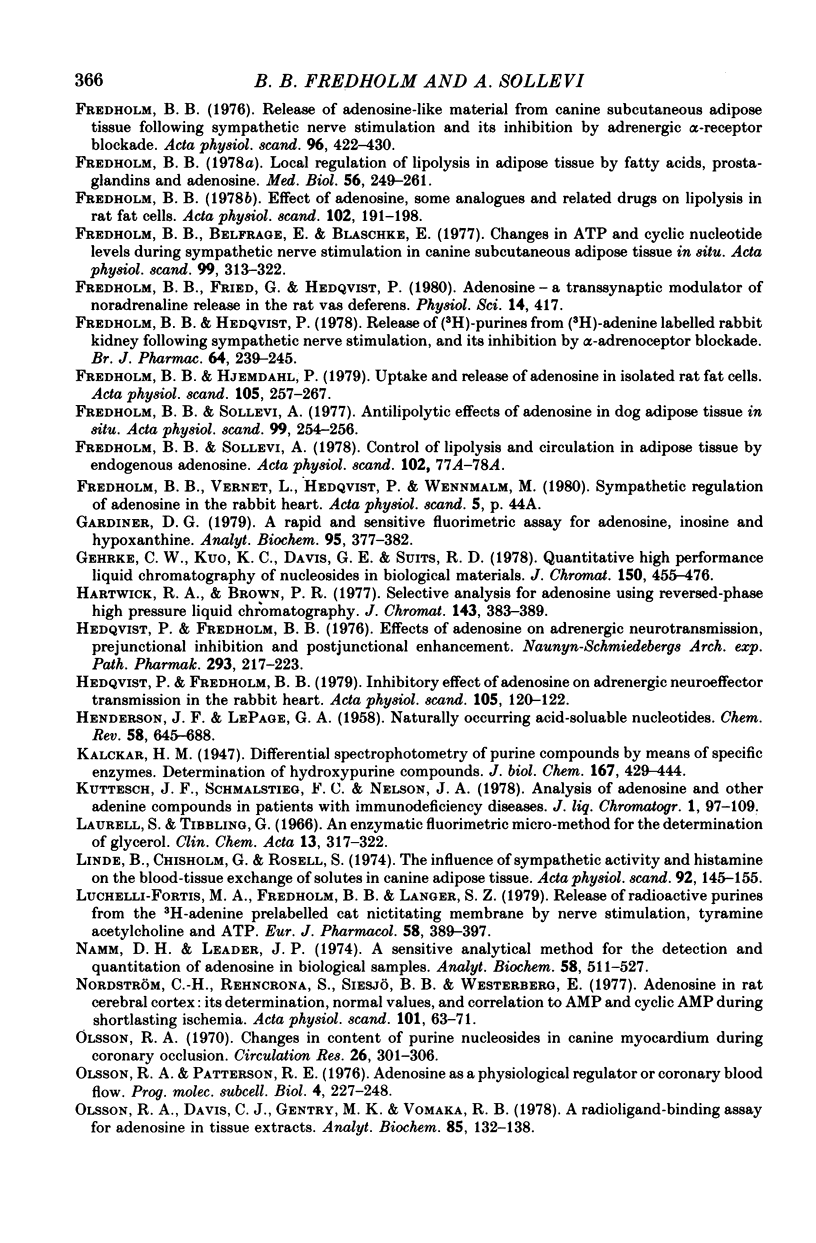
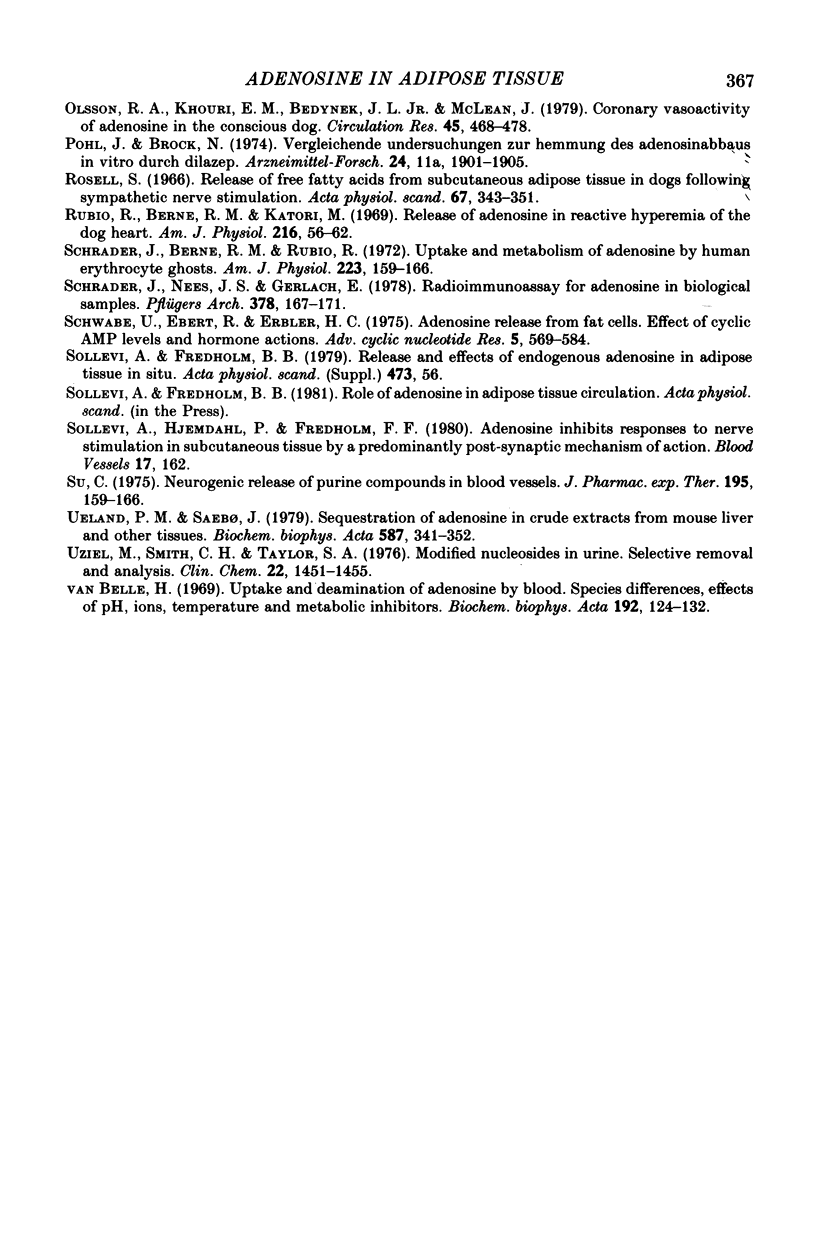
Selected References
These references are in PubMed. This may not be the complete list of references from this article.
- Anderson F. S., Murphy R. C. Isocratic separation of some purine nucleotide, nucleoside, and base metabolites from biological extracts by high-performance liquid chromatography. J Chromatogr. 1976 Jun 23;121(2):251–262. doi: 10.1016/s0021-9673(00)85021-9. [DOI] [PubMed] [Google Scholar]
- Arch J. R., Newsholme E. A. The control of the metabolism and the hormonal role of adenosine. Essays Biochem. 1978;14:82–123. [PubMed] [Google Scholar]
- BRETSCHNEIDER H. J., FRANK A., BERNARD U., KOCHSIEK K., SCHELER F. Die Wirkung eines Pyrimidopyrimidin-Derivates auf die Sauerstoffversorgung des Herzmuskels. Arzneimittelforschung. 1959 Jan;9(1):49–59. [PubMed] [Google Scholar]
- Bockman E. L., Berne R. M., Rubio R. Adenosine and active hyperemia in dog skeletal muscle. Am J Physiol. 1976 Jun;230(6):1531–1537. doi: 10.1152/ajplegacy.1976.230.6.1531. [DOI] [PubMed] [Google Scholar]
- Burnstock G., Cocks T., Kasakov L., Wong H. K. Direct evidence for ATP release from non-adrenergic, non-cholinergic ("purinergic") nerves in the guinea-pig taenia coli and bladder. Eur J Pharmacol. 1978 May 15;49(2):145–149. doi: 10.1016/0014-2999(78)90070-5. [DOI] [PubMed] [Google Scholar]
- Davis G. E., Suits R. D., Kuo K. C., Gehrke C. W., Waalkes T. P., Borek E. High-performance liquid chromatographic separation and quantitation of nucleosides in urine and some other biological fluids. Clin Chem. 1977 Aug;23(8):1427–1435. [PubMed] [Google Scholar]
- Dobson J. G., Jr, Rubio R., Berne R. M. Role of adenine nucleotides, adenosine, and inorganic phosphate in the regulation of skeletal muscle blood flow. Circ Res. 1971 Oct;29(4):375–384. doi: 10.1161/01.res.29.4.375. [DOI] [PubMed] [Google Scholar]
- Fain J. N., Malbon C. C. Regulation of adenylate cyclase by adenosine. Mol Cell Biochem. 1979 Jun 15;25(3):143–169. doi: 10.1007/BF00235364. [DOI] [PubMed] [Google Scholar]
- Fox I. H., Kelley W. N. The role of adenosine and 2'-deoxyadenosine in mammalian cells. Annu Rev Biochem. 1978;47:655–686. doi: 10.1146/annurev.bi.47.070178.003255. [DOI] [PubMed] [Google Scholar]
- Fredholm B. B., Belfrage E., Blaschke E. Changes in ATP and cyclic nucleotide levels during sympathetic nerve stimulation in canine subcutaneous adipose tissue in situ. Acta Physiol Scand. 1977 Mar;99(3):313–322. doi: 10.1111/j.1748-1716.1977.tb10384.x. [DOI] [PubMed] [Google Scholar]
- Fredholm B. B. Effect of adenosine, adenosine analogues and drugs inhibiting adenosine inactivation on lipolysis in rat fat cells. Acta Physiol Scand. 1978 Feb;102(2):191–198. doi: 10.1111/j.1748-1716.1978.tb06062.x. [DOI] [PubMed] [Google Scholar]
- Fredholm B. B., Hedqvist P. Release of 3H-purines from [3H]-adenine labelled rabbit kidney following sympathetic nerve stimulation, and its inhibition by alpha-adrenoceptor blockage. Br J Pharmacol. 1978 Oct;64(2):239–245. doi: 10.1111/j.1476-5381.1978.tb17295.x. [DOI] [PMC free article] [PubMed] [Google Scholar]
- Fredholm B. B., Hjemdahl P. Uptake and release of adenosine in isolated rat fat cells. Acta Physiol Scand. 1979 Mar;105(3):257–267. doi: 10.1111/j.1748-1716.1979.tb06340.x. [DOI] [PubMed] [Google Scholar]
- Fredholm B. B. Local regulation of lipolysis in adipose tissue by fatty acids, prostaglandins and adenosine. Med Biol. 1978 Oct;56(5):249–261. [PubMed] [Google Scholar]
- Fredholm B. B., Sollevi A. Antilipolytic effect of adenosine in dog adipose tissue in situ. Acta Physiol Scand. 1977 Feb;99(2):254–256. doi: 10.1111/j.1748-1716.1977.tb10377.x. [DOI] [PubMed] [Google Scholar]
- Fredholm B. B. Studies on the sympathetic regulation of circulation and metabolism in isolated canine subcutaneous adipose tissue. Acta Physiol Scand Suppl. 1970;354:1–47. [PubMed] [Google Scholar]
- Gardiner D. G. A rapid and sensitive fluorimetric assay for adenosine, inosine, and hypoxanthine. Anal Biochem. 1979 Jun;95(2):377–382. doi: 10.1016/0003-2697(79)90742-5. [DOI] [PubMed] [Google Scholar]
- Gehrke C. W., Kuo K. C., Davis G. E., Suits R. D., Waalkes T. P., Borek E. Quantitative high-performance liquid chromatography of nucleosides in biological materials. J Chromatogr. 1978 Mar 21;150(2):455–476. doi: 10.1016/s0021-9673(00)88205-9. [DOI] [PubMed] [Google Scholar]
- Hartwick R. A., Brown P. R. Selective analysis for adenosine using reversed-phase high-pressure liquid chromatography. J Chromatogr. 1977 Jul 1;143(4):383–389. doi: 10.1016/s0378-4347(00)80984-6. [DOI] [PubMed] [Google Scholar]
- Hedqvist P., Fredholm B. B. Effects of adenosine on adrenergic neurotransmission; prejunctional inhibition and postjunctional enhancement. Naunyn Schmiedebergs Arch Pharmacol. 1976 Jun;293(3):217–223. doi: 10.1007/BF00507344. [DOI] [PubMed] [Google Scholar]
- Hedqvist P., Fredholm B. B. Inhibitory effect of adenosine on adrenergic neuroeffector transmission in the rabbit heart. Acta Physiol Scand. 1979 Jan;105(1):120–122. doi: 10.1111/j.1748-1716.1979.tb06321.x. [DOI] [PubMed] [Google Scholar]
- Laurell S., Tibbling G. An enzymatic fluorometric micromethod for the determination of glycerol. Clin Chim Acta. 1966 Mar;13(3):317–322. doi: 10.1016/0009-8981(66)90210-5. [DOI] [PubMed] [Google Scholar]
- Linde B., Chisolm G., Rosell S. The influence of sympathetic activity and histamine on the blood-tissue exchange of solutes in canine adipose tissue. Acta Physiol Scand. 1974 Oct;92(2):145–155. doi: 10.1111/j.1748-1716.1974.tb05731.x. [DOI] [PubMed] [Google Scholar]
- Luchelli-Fortis M. A., Fredholm B. B., Langer S. Z. Release of radioactive purines from cat nictitating membrane labeled with 3H-adenine. Eur J Pharmacol. 1979 Oct 15;58(4):389–397. doi: 10.1016/0014-2999(79)90309-1. [DOI] [PubMed] [Google Scholar]
- Namm D. H., Leader J. P. A sensitive analytical method for the detection and quantitation of adenosine in biological samples. Anal Biochem. 1974 Apr;58(2):511–524. doi: 10.1016/0003-2697(74)90219-x. [DOI] [PubMed] [Google Scholar]
- Nordström C. H., Rehncrona S., Siesjö B. K., Westerberg E. Adenosine in rat cerebral cortex: its determination, normal values, and correlation to AMP and cyclic AMP during shortlasting ischemia. Acta Physiol Scand. 1977 Sep;101(1):63–71. doi: 10.1111/j.1748-1716.1977.tb05984.x. [DOI] [PubMed] [Google Scholar]
- Olsson R. A. Changes in content of purine nucleoside in canine myocardium during coronary occlusion. Circ Res. 1970 Mar;26(3):301–306. doi: 10.1161/01.res.26.3.301. [DOI] [PubMed] [Google Scholar]
- Olsson R. A., Davis C. J., Gentry M. K., Vomacka R. B. A radioligand-binding assay for adenosine in tissue extracts. Anal Biochem. 1978 Mar;85(1):132–138. doi: 10.1016/0003-2697(78)90283-x. [DOI] [PubMed] [Google Scholar]
- Olsson R. A., Khouri E. M., Bedynek J. L., Jr, McLean J. Coronary vasoactivity of adenosine in the conscious dog. Circ Res. 1979 Oct;45(4):468–478. doi: 10.1161/01.res.45.4.468. [DOI] [PubMed] [Google Scholar]
- Pohl V. P., Brock N. Vergleichende Untersuchungen zur Hemmung des Adenosinabbaus in vitro durch Dilazep. Arzneimittelforschung. 1974 Nov;24(11A):1901–1905. [PubMed] [Google Scholar]
- Rosell S. Release of free fatty acids from subcutaneous adipose tissue in dogs following sympathetic nerve stimulation. Acta Physiol Scand. 1966 Jul-Aug;67(3):343–351. doi: 10.1111/j.1748-1716.1966.tb03320.x. [DOI] [PubMed] [Google Scholar]
- Rubio R., Berne R. M., Katori M. Release of adenosine in reactive hyperemia of the dog heart. Am J Physiol. 1969 Jan;216(1):56–62. doi: 10.1152/ajplegacy.1969.216.1.56. [DOI] [PubMed] [Google Scholar]
- Schrader J., Berne R. M., Rubio R. Uptake and metabolism of adenosine by human erythrocyte ghosts. Am J Physiol. 1972 Jul;223(1):159–166. doi: 10.1152/ajplegacy.1972.223.1.159. [DOI] [PubMed] [Google Scholar]
- Schrader J., Nees S., Gerlach E. Radioimmunoassay for adenosine in biological samples. Pflugers Arch. 1978 Dec 28;378(2):167–171. doi: 10.1007/BF00584451. [DOI] [PubMed] [Google Scholar]
- Schwabe U., Ebert R., Erbler H. C. Adenosine release from fat cells: effect on cyclic AMP levels and hormone actions. Adv Cyclic Nucleotide Res. 1975;5:569–584. [PubMed] [Google Scholar]
- Su C. Neurogenic release of purine compounds in blood vessels. J Pharmacol Exp Ther. 1975 Oct;195(1):159–166. [PubMed] [Google Scholar]
- Ueland P. M., Saebø J. Sequestration of adenosine in crude extract from mouse liver and other tissues. Biochim Biophys Acta. 1979 Oct 18;587(3):341–352. doi: 10.1016/0304-4165(79)90438-0. [DOI] [PubMed] [Google Scholar]
- Uziel M., Smith L. H., Taylor S. A. Modified nucleosides in urine: selective removal and analysis. Clin Chem. 1976 Sep;22(9):1451–1455. [PubMed] [Google Scholar]
- Van Belle H. Uptake and deamination of adenosine by blood. Species differences, effect of pH, ions, temperature and metabolic inhibitors. Biochim Biophys Acta. 1969 Oct 7;192(1):124–132. doi: 10.1016/0304-4165(69)90017-8. [DOI] [PubMed] [Google Scholar]


